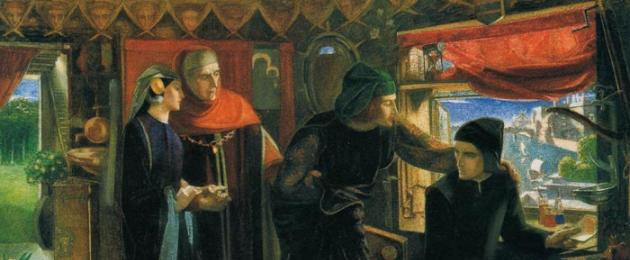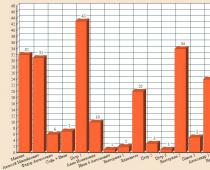Dante Gabriel Rossetti (1828-1882) English poet, translator, illustrator and painter. is a new name for us. We haven't reviewed his work yet.
Dante Gabriel Rossetti Portrait by George Frederic Watts
I drew attention to one of his portraits. "Bocca Baciata". The eyes of the girl were especially attracted. Is there sadness or a dream of something unrealizable in them?
The name of the painting literally means "lips that kissed", the words are taken from the Italian proverb, which is indicated on the back of the painting:
Bocca baciata non perde ventura, anzi rinnova come fa la luna.
‘lips after a kiss do not lose their taste, on the contrary, it is renewed like the moon.’

Dante Gabriel Rossetti. Bocca Baciata» After the kiss. 1859
The work was the first single female portrait painted by Rossetti, thus becoming a turning point in his creative biography. The model for the picture was Fanny Cornforth . The painting is currently in Museum of Fine Arts Boston.
In one of his letters, Rossetti explained that while painting this picture, he tried to paint the body, the flesh of the heroine, as best as possible, which, in his opinion, was not sufficiently worked out on many works of art, including works Pre-Raphaelites as well as old masters; more careful work on the image of the body could help to advance significantly in painting.
A LITTLE ABOUT THE ARTIST.
Dante Gabriel Rossetti was born on May 12, 1828 in London in the family of an Italian political immigrant, poet and scientist. Rossetti from childhood was attached to the masterpieces of Italian literature, to Dante's "Divine Comedy", and these impressions marked all his work.
Multi-talented, temperamental in Italian and dreamy in English, Rossetti, at the age of 18, became the head of the Pre-Raphaelite Brotherhood, which were essentially romantics. Together with William Holman Hunt, Milles, seeing the blind imitation of the old patterns, decided to leave the academy and rushed to the "search for inner truth"

Self portrait, 1847
The very word "brotherhood" conveyed the idea of a closed, secret society, similar to medieval monastic orders. The desire for truth and simplicity and a romantic rejection of reality were combined with a retreat into a more attractive, in their opinion, past, into a world of fantasy.
Young artists sought support not only in the art of the Early Renaissance, whose masters attracted them with sincerity of feeling, purity and simplicity of forms, and an inquisitive attitude to the world. They were fond of the Middle Ages, the poetry of the English romantics.
In 1850, Gabriel Rossetti exhibited the painting "Esce ancilla domini" (lat. "Servant of the Lord"), which depicted the Annunciation

Rosseti Annunciation.
In an empty room, on a narrow couch, clinging to the wall and looking down, sits young Mary, who appears not in the form of the Heavenly Queen, but a girl, embarrassed by the news brought by the Archangel. Before Her stands a beautiful Archangel, whose heavenly origin is indicated by a halo over her head and flames under her feet.
Gabriel has a white lily in his right hand (a symbol of the virgin purity of the Virgin Mary), the girl’s enchanted gaze is riveted to her, with her left hand the Archangel sends her a message - a stream of Divine, life-giving energy. A dove hovers above his hand - a symbol of the Holy Spirit. In front of Mary's bed there is a loom with a lily already embroidered on scarlet fabric. The spindle and the spinning wheel are symbols of the charitable work that the Virgin Mary was engaged in.
The public did not like the painting "The Annunciation": the artist was accused of imitating the old Italian masters. The realism of the image caused strong disapproval (including Charles Dickens).
Rossetti created his most significant works in the 1850s - early 1860s. Under the influence of William Blake, his poetry and mystical painting, Rossetti managed to create his own special style, symbolic, decorative, full of mystical echoes.
Rossetti builds the original composition on a combination of several large-scale foreground figures, increasing the size of the canvases to fit human figures and life-size objects. Many objects and images make up the background of the picture.
Details and characters are full of deep subtext, hidden meaning, which portends European symbolism. Real characters and details, as if snatched from life, were combined in the background of the canvas with fantastic figures and symbolic elements that gave the composition an unreal look of a mirage.
Like the Symbolists, the characters are outwardly static, deepened in their own thoughts, but internally they are filled with a tense deep feeling, which is revealed in the look, gesture. The master is not afraid to exaggerate the proportions of the body or hands, unusual angles, complex productions.
Rossetti's painting, unlike the art of other Pre-Raphaelites, is not characterized by naturalistic elements, it is not only decorative, but also monumental.
In 1850, Rossetti met his muse - Elizabeth, in 1860 she became his wife. During this period, Rossetti creates an exciting gallery of female images, fiery-passionate and dreamy-sad, - the presence of Elizabeth is invariably felt in them.
Under the arch of life, where love and death,
Terror and mystery guard her sanctuary, I saw
The beauty that sat on the throne...-
wrote Dante Gabriel Rossetti, referring to beauty, the muse that inspired his art from an early period of splendor and splendor until the last years of decline:
O secret of Beauty!
Who can tell of your mighty influence?
Rossetti devoted his work to the chanting of the ideal female image embodied in an early deceased wife. Her unusual appearance attracted many like-minded people who deliberately avoided professional models; Elizabeth's features became a kind of canon of female beauty.

Beata Beatrix, 1864-1870. Portrait of Elizabeth Siddal

First anniversary of Beatrice's death (1853)
The woman he loved without memory died two years after their wedding. Together with Elisabeth, "the muse of the Pre-Raphaelites", Rossetti buried the manuscripts of many poems (later published). Inspired by Dante's poetry, he resurrected her features in the paintings in the guise of Beatrice - "Death of Beatrice", "Blessed Beatrice", "Dante's Dream".
The death of his wife in 1862 was a personal and creative tragedy for the artist. Rossetti began to lead an increasingly withdrawn lifestyle. He refused to exhibit his works as early as 1850, after a fierce attack by critics on the Pre-Raphaelites.
In the late period of his work, Rossetti began to build his compositions on the image of a single, focused on his thoughts, idealized female figure. This look was inspired by Jane Verden, the wife of his friend William Morris, who became Rossetti's second muse. The late style of the artist includes paintings"Proserpine" , "Mariana", "Veronica Veronese", "Monna Vanna" and others.

Proserpine.
Rossetti wrote about Proserpine following:
"She is depicted in a gloomy corridor of her palace, with a deadly fruit in her hand. She passes by, and a reflection of light falls on the wall behind her from some suddenly opened aperture, showing for a moment the upper world, and she stealthily glanced at him, immersed in your thoughts.
Next to her is a censer - an attribute of the goddess. The branch of ivy in the background can be seen as a symbol of a clinging memory"
Beloved.
In the picture, the bride opens her veil, next to her are four girls and an African page boy. When working on "Beloved" Rossetti was inspired by the works Edouard Manet, in particular the Olympia ", created in the same year (in particular, this work led him to create a strong contrast between the bright hair and features of the bride, the rest of the girls in the picture and the boy), as well as the works Titian
Rossetti completed the painting in 1866, but continued to make changes to the canvas throughout his life.
“The strongest charms and the most vivid memories are transmitted to the connoisseur of beauty through the female gaze,” Frederick Myers noted in the essay “Rossetti and the Religion of Beauty” (1883).

Veronica Veronese.
Veronica Veronese was inspired by Venetian painting. It depicts "the creative soul during the act of creation." This theme is also reflected in the inscription on the frame, signed as a quote from the "Letters of Girolamo Ridolfi"; according to critics, the quote belongs to Algernon Charles Swinburne or Rossetti himself.
The inscription on the frame.
“Suddenly, leaning forward, Lady Veronica quickly wrote the first notes on the pristine page. Then she took the bow of her violin to make her dream come true, but before starting to play the instrument hanging from her hand, she remained for several seconds in silence, listening to the birds that inspire her, while her left hand wandered over the strings in search of a higher melody, still elusive.
Rossetti's picturesque and poetic work merged: he painted paintings on the themes of poetry and poems commenting on the paintings - "The Blessed Virgin", "Sister's Dream", "Last Confession".

Vision of Fiammetta. 1878

Pia de Tolomei. 1868
The picture was painted during the beginning of a long romance between the artist and the model. Jane Morris , the artist's wife William Morris . The motif was chosen as a plot fromPurgatory Divine Comedy by Dante Alighieri . Pia de Tolomei is a woman sent to prison and poisoned by her husband.
Rossetti wanted to show that William Morris held his wife captive in the same way. He reflected the same in his later work."Proserpine"During Rossetti's lifetime, Jane was portrayed in images Proserpines, Guineveres and Desdemonas - women who were at the mercy of their husbands

Water willow.
He also left literary works: a translation of ancient Italian poets, Civollo D "Alcamo, Dante, published two volumes of original poems and a collection of ballads and sonnets (1881), remarkable for the strength and melodiousness of the language, subtle poetic feeling and mysticism, combined with passion.
The works of the last period of his life were written under the influence of W. Morris and E. K. Burne-Jones ("Day Dreams", 1880, Victoria and Albert Museum, London).
Rossetti died at Birchington on April 9, 1882. A complete exhibition of works was shown only two months after his death and was a huge success.
Rossetti's work had a huge impact on many English artists of the late 19th and early 20th centuries. Numerous imitators and students make up the so-called Rossetism.
- In contact with 0
- Google Plus 0
- OK 0
- Facebook 0








